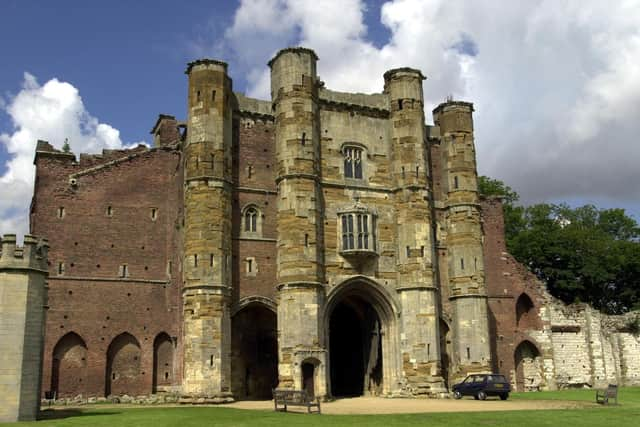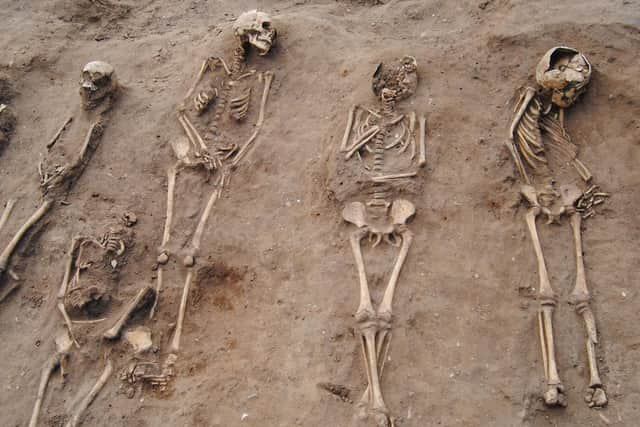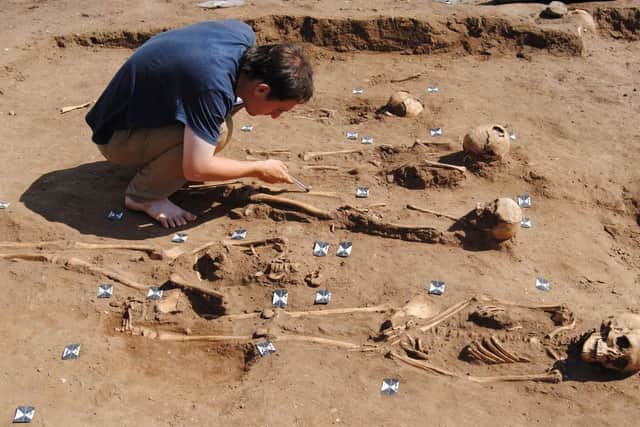The largest Black Death mass grave outside London has been found near the Humber


The mass grave containing at least 48 bodies of bubonic plague victims was found at Thornton Abbey, an English Heritage-managed site near Barton-upon-Humber, in 2013, but the discovery was not made public at the time.
Archaeologists from the University of Sheffield have only just published their findings after seven years of analysis and research, which included DNA testing carried out by a Canadian university using bacterial dating technology that has only been available for around five years.
Advertisement
Hide AdAdvertisement
Hide AdAn Iron Age shield found in Pocklington is one of the most important ancient finds made this millenniumThe pit has been dated to the devastating 1348-9 outbreak of plague, which wiped out as much as half of the English population in just 18 months and spawned the 'Black Death' nickname after the dark abscesses which formed on sufferers' skin.


The Thornton Abbey skeletons have astonished historians, as the few mass burial sites previously excavated in Britain were found in London. It had always been thought that in rural areas where the population was sparse, Black Death victims would have been interred in their local churchyard with proper ceremony.
The fatality rate at Thornton Abbey suggests that the disease was so virulent on the Humber Estuary that priests and gravediggers were overwhelmed by the demand for quick burials.
Archaeologists believe that the 48 victims found wrapped in shrouds in a sandy pit died within days of each other and had fled to the abbey to seek care and medical attention from the monks who lived there.
Advertisement
Hide AdAdvertisement
Hide AdDNA tests on the remains of the men, women and children revealed the presence of the bubonic plague pathogen.


University of Sheffield archaeologist Dr Hugh Willmott said that no comparable burial site had ever been discovered in the countryside.
His research, published this month in the academic journal Antiquity, asserts that the find is of national significance.
The bodies were uncovered by chance during a survey of the Augustinian priory ruins, and the site of a medieval hospital was also excavated nearby. The team of archaeologists were actually looking for evidence of the land's occupation following the Dissolution of the Monasteries, after which it was passed down through several private owners.
Advertisement
Hide AdAdvertisement
Hide AdTheir geophysical surveying equipment identified a dense feature below ground that they originally thought were the foundations of a building.


"It was a complete accident - like all of the best finds. The survey seemed to show what seemed to be a building. Within five minutes of lifting the turf, the first skull was grinning back at us!" said Dr Willmott.
The dig took two years to complete and there was then a further delay before publication of the findings while McMaster University in Ontario undertook DNA analysis. The Canadian scientists are the world leaders in ancient DNA study.
Iron Age chariot with horses leaping out of the grave found in East Yorkshire"There are two reasons why this find is so rare. One is that in most places, plague victims were buried as normal in individual graves, so we wouldn't necessarily know which contained someone who had died of the Black Death. The other is that larger pits were usually in parish churchyards - many of these medieval churches are still in use today and we don't usually dig them up.
Advertisement
Hide AdAdvertisement
Hide Ad"The grave was found in an area of the abbey precinct that isn't usually accessible to the public. The abbey records from that period were lost, but we do have documented evidence of the Black Death in the area and of monks dying from it at other abbeys nearby.
"It arrived on the south coast of England in 1348 and moved north, arriving in Lincolnshire in the spring of 1349 when the weather was warming up, so it was particularly devastating in the east.
"The abbey did recover - what's fascinating is that despite the high mortality rate, life carried on and society didn't fall apart. The role and influence of the Church was key to that."
The skeletons from the abbey are being stored in a basement at the university's archaeology department before any decision is made on whether to put them on public display.
Advertisement
Hide AdAdvertisement
Hide Ad"We've got no plans for an exhibition at the moment. Thornton Abbey is an English Heritage site, but due to its location it doesn't get that many visitors. We may work with them to do something that contributes to the enhancement of our other finds.
"Thornton is off the beaten track and it is very well-preserved - it has few walls still standing but below ground it remains undisturbed."
However, Dr Willmott does not believe the discovery will lead to further searches for mass graves within abbey grounds.
"It's still like looking for a needle in a haystack and it's difficult to spot a mass grave. However, this find might contribute to research into why there are so few of these pits. Archaeologists may start to look at normal graves and do DNA work on the remains to establish which diseases people died from.
Advertisement
Hide AdAdvertisement
Hide Ad"There is a lot of historical interest in plague burials, and the recent DNA advances have revived that interest - people are now studying outbreaks in the sixth century.
"I feel very lucky and privileged to have made this discovery - especially as I didn't set out to look for it."
The plague pits found in Britain
Wherever possible, plague victims were buried in churchyards - there are only a few sites that have been discovered that can be classed as 'mass graves', and all are in London.
London also suffered a severe outbreak of bubonic plague in 1665, known as the Great Plague, when 100,000 people died - the Black Death is usually used to refer to the 14th-century pestilence.
Advertisement
Hide AdAdvertisement
Hide AdA dig at East Smithfield in the 1980s uncovered the remains of 759 people, although the pit was thought to hold as many as 2,400 victims of the 1340s epidemic. They were only confirmed as plague sufferers in 2011, when DNA analysis was conducted.
It was an emergency burial ground purchased when it became apparent the plague was sweeping through Europe.
When the Crossrail project began in 2014, a test dig was held at what would have been the second of these burial grounds - West Smithfield, which is now beneath Charterhouse Square.
Burials from three separate outbreaks in 1348, 1361 and 1430 were confirmed after DNA isotopes were studied. Bones had been previously found there by Victorian labourers working on sewage systems.
Advertisement
Hide AdAdvertisement
Hide AdThe 18ft shaft that was initially excavated contained 25 skeletons interred in 1348. The East and West Smithfield sites are the only confirmed Black Death burial grounds to have been discovered - despite rumours of around 40 more scattered over the city.
However, in 2015 Crossrail engineers made another significant find - the first burial site dating from the Great Plague of 1665.
They came across human remains during work on the ticket hall at Liverpool Street Station. Previously, none of the 1665-era plague pits that were believed to exist in London had ever been conclusively found.
A total of 3,500 bodies were buried beneath the station - most dated from the 16th and 17th centuries, when the land was part of Bedlam Cemetery. But 42 were different from the rest - they were found in a single mass grave. They were stacked four deep and appeared to have been buried in haste on the same day.
Advertisement
Hide AdAdvertisement
Hide AdDNA analysis later identified the plague pathogen, and they are the only Great Plague victims ever exhumed in Britain to date.
In 1993, a burial ground found beneath Hereford Cathedral was linked to the Black Death, but the remains were never studied or the findings publicised.